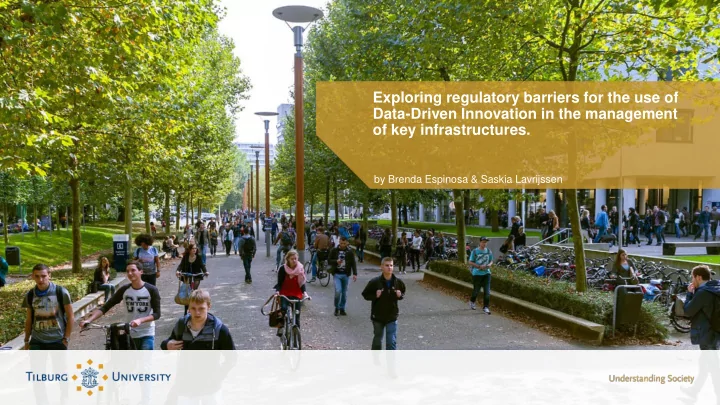

Exploring regulatory barriers for the use of Data-Driven Innovation in the management of key infrastructures. by Brenda Espinosa & Saskia Lavrijssen
Outline 1. Research Background 2. DDI & infrastructure management ‘ Regulatory gaps ’ as a barrier for using DDI in infrastructure management. 3. 3.1. ‘ Regulatory disconnection ’ 3.2. Illustrating the disconnection 4. Conclusions 5. Insights for further research
1. Research Background • Legal & Organisational Network & Governance Aspects of Data- Driven Innovations in Infrastructure Management (LONGA VIA) – NGInfra Responsive Innovations Programme. • Project leader: Saskia Lavrijssen. Objectives: • Identifying legal/regulatory barriers (focus on Dutch and EU level) for the implementation of DDI in smart operation and maintenance of the infrastructures & cooperation across sectors (focus on energy, water and transport). • Developing policy recommendations to address the identified barriers.
2. DDI & infrastructure management • Definition of Data-Driven Innovation (DDI): Significant improvement of existing, or the development of new, products, processes, organisational methods and markets arising from the dynamics generated by the use of big data (OECD, 2015). • ‘ The rise of Big Data’ Increasing availability of large amounts of data at low cost. Increasing ability of organizations to analyze and extract value from data. (Mayer-Schönberger and Cukier, 2013). • Big Data as a driver of innovation (positive economic and social impact). http://www.oecd.org/innovation/data-driven-innovation-9789264229358-en.htm
2. DDI & infrastructure management Opportunities brought by DDI in infrastructure management. • Key role of infrastructure in society’s life. • Public values associated to infrastructure (e.g. affordability, reliability, safety, sustainability, efficency). • Examples of DDI for infrastructure management (sensors, smart meters, smart grids, IoT, AI). Transport Energy Water Integration of multiple sectors. • Regulatory barriers (broad sense) may deter/create challenges for the use of DDI in infrastructure management. https://www.etfresearchcenter.com/articles/index.php/2017/03/14/etfs-for-an- infrastructure-surge/
3. ‘ Regulatory gaps ’ as a barrier for using DDI in infrastructure management. • Report on the Impacts of EU Regulatory Barriers on Innovation (European Commission, 2017): Focus on energy, water, health and food sectors. Gaps in regulations and other regulatory issues may hamper innovation. Addressing regulatory barriers contributes to increase investments in innovation. • Special challenges in the context of infrastructure management: • Energy, water, transport are highly regulated sectors. • Uncertainty regarding responsibilities and rights. • Doubts regarding cost recovery (tariff regulations). • Uncertainty of the approach that future regulations will follow. http://publications.europa.eu/resource/cellar/6e4ce9f8-aa41-11e7-837e-01aa75ed71a1.0001.01/DOC_1 http://sustainablejill.com/does-your-personal-effort-to-save-the-environment-make-any-difference/question- mark-red-3d-glossy/
3.1. ‘ Regulatory disconnection ’ Flexibility and adaptability → key • Term coined by Law & Technology scholarship to refer to “law’s aspects to enable innovation. race to keep up with technological change” (L. Moses, 2007). Different regulatory strategies: • Technological innovation opens up new possibilities of action → • Who creates the rules? Agency specialized on innovation. reveals different regulatory issues, including gaps. Co-regulation Self-regulation • Gaps = need for rules to limit or enable innovation. • Broadness of the rules Principles-based • 2 major roles of regulation with regard to innovation: Technology neutral ‘ Sui generis rules ’ • Filter out unethical or problematic innovations → precautionary intervention. • Monitoring and adaptation Mandatory periodic reviews. • Maximize benefits and minimize harms → facilitation or promotion. ‘ Sunset clauses ’ Experimental legislation http://self-love-u.blogspot.com/2017/07/disconnection-is-rejection.html
3.2. Illustrating the disconnection Smart Water Meters (SWM) for households in the Netherlands • No European or Dutch legislation (unlike electricity and gas smart meters). • Technology is available but Dutch drinking water companies have not initiated a roll-out for households. • Applying the theoretical framework of ‘ regulatory disconnection ’ No inmediate threat to health, environment or human dignity → no need for precautionary intervention. Rules might be necessary to reap benefits and control risks: Benefits: Timely monitoring; precise consumption measurement; easing and lowering the cost of meter reading; balancing customer demand; prompt leaking detection and reparation. Linked to public interests behind drinking water supply: affordability, security of supply, rational use, consumer protection. Risks: Mainly related to privacy concerns → insights into private and family life. Dutch experience with regulations for electricity smart meters
4. Conclusions • DDI has the potential to improve the management of infrastructures used in key sectors (energy, water and transport) → achievement of public values (e.g. reliability, affordability, safety, sustainability). • DDI raises questions regarding the suitability of existing regulatory frameworks to acknowledge and deal with both the opportunities and possible risks, often evidencing regulatory gaps. • The lack of rules → uncertainty regarding the possibilities of action in highly regulated sectors → hinders innovation and prevents the realization of the advantages that DDI may bring for the general public. • Regulatory gaps → result of a disconnection between increasingly fast technology and legal systems that are not sufficiently flexible and adaptive. • New rules might be necessary to govern new dynamics enabled by innovation → limit harms and maximize benefits. • Opportunities and risks should be adequately balanced when deciding if a certain type of DDI is worth promoting via the enactment of regulations, and how those regulations should look like. Privacy → pressing issue in light of DDI.
Further Research • Other types of barriers/challenges (outdated regulations, stringent requirements, unclear regulations, etc.) • Governance of data: who retains the ownership? for which purposes can data be used? who can access the data? will the Clean Energy Package contribute to solve these questions in the energy sector? • In European context: impact of GDPR (and proposed e-privacy Regulation) in the management of personal data employed by DDI in infrastructure management. • Exploring the synergies that cross-sectoral cooperation in the management of infrastructure can enable, particularly by means of data sharing, and the regulatory challenges that come along with it. • Common governance issues related to DDI in different infrastructure sectors → opportunity to think of a cross- sectoral regulatory approach? • Comparative research to identify approaches employed around the globe.
Contact Brenda Espinosa PhD Researcher at TILEC (Tilburg University) E-mail: B.P.EspinosaApraez@uvt.nl
Recommend
More recommend